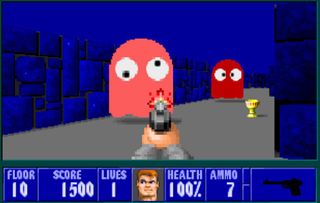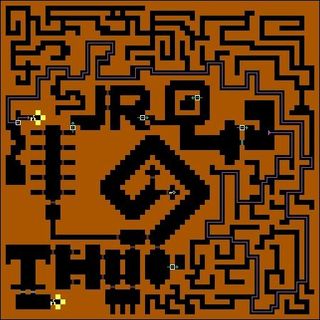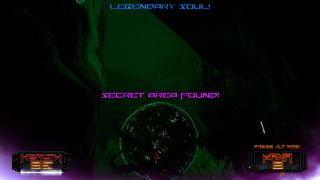How secret rooms created the magic and mystery of '90s first-person shooters
The definitive history of why so many shooters told you "A secret is revealed!"

My enduring memory of the original Doom isn't sprinting from room to room shotgunning demons. It's rubbing against every suspicious wall, hammering the spacebar while Doomguy grunts and textures blur. Or flipping a switch, hearing a door open, then working back through the level to figure out where. That was the only way to find those secret rooms and avoid the frustration of finishing a level with a score of SECRETS FOUND: HA HA YOU SUCK%.
David Kushner's book Masters of Doom tells the story of how id went from making Commander Keen platformers to the definitive first-person shooters. It mentions that Scott Miller, founder of Apogee, wrote to id to suggest the first Keen game should have secret areas to increase its replay value, just as the Super Mario games had. John Romero, interviewed by our own Wes Fenlon, says their inclusion was never in question. "Of course Commander Keen is so Mario-like we had to put secrets in there," he says, "and so all the Commander Keen games have tons of secrets in them. Because the secrets in Commander Keen are so great and so fun, when we started making our shooters, even Catacomb 3-D had secrets in it."
Catacomb 3-D is often forgotten, but it was an important step between Hovertank 3D and Wolfenstein 3D back in the days when id felt the need to tell you in the title exactly how many dimensions a game had. But even though Catacombs 3-D demonstrated that secret areas worked in first-person—that it was fun to see a doorway appear in front of you, revealing a space you could walk around as if you were actually there—Wolfenstein 3D almost didn't have them.
In Catacomb 3-D you were a wizard who cast fireballs at walls to reveal their secrets, and even entire hidden levels. Wolfenstein's Nazi-busting hero B.J. Blazkowicz didn't have that option, since the only fireballs he saw were being cast by floating Hitler wizards that are apparently, according to the official hint book, dummies suspended on wires with chest-mounted flamethrowers. (Wolfenstein was an odd game.)
At the time id's Tom Hall was adamant it would be OK to just have wall sections slide away, but John Carmack had programmed an engine where that wasn't possible without a kludgy addition. "Carmack didn't wanna violate the purity of his engine by putting this hack in there," says Romero. "But he did it. We spent a couple months, it was probably two months—and Wolfenstein took four months to make, so probably half the time was trying to convince John to put this damn hack in there."
We were taught by Miyamoto
John Romero
It was worth it. Every suspicious cross or portrait of Hitler was studiously pressed by players in search of secrets like the hidden maze in E3M7, with push walls concealed behind other push walls, leading to a secret exit. Finding that secret exit unlocks one of Wolfenstein's hidden levels, which is modeled after Pac-Man complete with invincible ghosts. You have to navigate an absurd number of secrets within secrets and a maze that spells out its creators' initials, but the reward is an easter egg that's still memorable decades later.

"We were taught by Miyamoto," says Romero. "Why wouldn't we do this? We did that in Wolfenstein. And then in Doom it was like, these secrets can be even cooler than the ones that were in Wolfenstein."
The biggest gaming news, reviews and hardware deals
Keep up to date with the most important stories and the best deals, as picked by the PC Gamer team.
Part of what made Wolfenstein's secrets hard to find was that they were often triggered by completely random sections of wall. With a new engine, a lot more textures, and an in-game map, Doom made it simpler to flag suspicious wall sections so alert players would notice them.
"id Software had included secret areas in Wolfenstein 3D but to find them you basically had to walk up to every single wall and bump it to see if it opened, " says Sandy Petersen, who designed 19 of Doom's levels. "We decided that was boring and sucky, so we decreed that in Doom, there would be a clue for every secret. And there is. Sometimes it's pretty subtle, but it’s always there."
Petersen's work makes up most of Doom's second and third episodes. His levels are notable for being less sci-fi and more occult, with Satanic imagery and walls made of screaming faces. The Slough of Despair—E3M2 to use its more prosaic name—is one of his, with a map shaped like a clutching hand. Bring up the map to see that claw-like shape and you might also spot a rock shaped like an arrow, which points to a concealed plasma gun and a medkit. That's one of Petersen's clues.
Though id followed the rule of always having a clue, they didn't have guidelines for how to go about designing the secrets, Petersen explains. "We just wanted to make them super-fun. We did have feedback and suggestions. For example, I’d play one of John Romero’s levels and say, 'this off-set texture hiding your secret door is too obvious—can you make it more subtle.' Or he'd say, 'Sandy, this giant room screams for a secret somewhere.' And I'd add one. Also, sometimes John Carmack or another programmer would say, 'I just implemented the ability to add timers to doors and stuff. Can you use it?' Then I'd go and add timer-based secrets to several levels."
The Doom games continued Wolfenstein's tradition of assigning a score at the end of each level, including a percentage of secrets found. Its ports also noted when players found secrets with a little fanfare: "A SECRET IS REVEALED!" This was a reward, but also an inspiration. It made you feel clever, and then made you want to find the next one. That would become a key piece of secret design for the rest of the decade.
Secret doors spread
Back when shooters were still called 'Doom Clones,' this was one of the traditions they copied. Subsequent shooters like Heretic and Star Wars: Dark Forces announced and gave scores for their secrets, just as Doom had.
1994's Rise of the Triad was particularly dense with secrets. At the start of the very first map you see a rocket launcher behind a fence you'll be able to bypass later when you press a touchplate, but even before that if you turn to the right, shoot a brazier and trigger a pushwall you'll find a secret area that contains another pushwall leading to a second secret. This is all in the first five minutes.
Duke Nukem 3D, released a year later, was similarly riddled with secrets, often highlighting its innovation of highly destructible levels. Cracked walls opened into the cinema via the front and let you pass directly through its screen, but they were only destructible with a rocket launcher found in a hidden room earlier in the level. Just like Wolfenstein, secrets were concealed within secrets.
Despite so many early shooters having "3D" in their names, it was all an illusion built on sprites and trickery. In 1996, Quake brought real-time 3D rendering to first-person shooters and popularized jumping while it was at it. This would be the next step (or leap) in how first-person games handled their secret rooms.
Petersen returned to design seven levels for Quake, including the first Quake level made in development: The Nameless City. "I wanted to show players the basics of jumping," he says, "so in an alleyway, I put in an obvious wall switch that they couldn't reach by jumping up. Instead they had to run into a neighboring building, go upstairs, then jump out of the window across the alley to hit the switch. Presto. I had a fun secret, and felt I'd given the players a teensy tutorial."
This level ended up being E4M8. A secret itself, it's accessible only by jumping across poles in E4M5, Hell's Atrium. Petersen says it was moved because the art, which was done in an early stage of development, "wasn’t felt to be as clean as later efforts. So that secret is no longer helpful as a tutorial, but I think it still serves the function of making players feel smart when they find it."
I put red glaring eyes in the 'kitchen'. If you shot them, a door opened. I told my wife the eyes were supposed to be her.
Sandy Petersen
Another innovation of the Quake engine: Physics, which made it possible to ride explosions, a trick speedrunners would exploit to rocketjump through levels in record times. In a way that's the game working as intended. One of Petersen's favorite secrets in Quake relies on it. It's hidden in E4M4, The Palace of Hate, "where the slipgate is overhead, and you have to get into it by lobbing in a grenade, then standing on it so it blasts you up."
While more complicated secrets were possible in Quake, they were more difficult to make. "Because it was 3D and things are solid," Romero explains, "Solid geometry—with Doom, it was line segments. I could just draw three lines and I have a room and then I draw two lines and I have a door. And we're talking in one minute, no problem."
In Quake, doors needed space to recede into and new ways to activate them. "So I made the door in Quake that, like, you shoot it and it goes in and it slides sideways," Romero says. "That utility door was really important for us to keep the consistency of the secrets, and to actually make it slightly easier for all of us to make secrets. Like OK, at least we don't need to think about the door."
Secret doors that were opened by shooting them became a hallmark of Quake, tempting players to waste their ammo hurling nails around. They'd experimented with the idea previously, but less often, like in Doom 2's MAP 16: Suburbs. It was another Petersen creation. "I based the starting house on my own house. I put red glaring eyes in the 'kitchen'. If you shot them, a door opened. I told my wife the eyes were supposed to be her. Still not sure if she was flattered or angered. Her reaction was… hard to read."
Secrets fall out of fashion
While secret areas were getting harder to code, they were still a popular inclusion in practically all shooters in the Quake era. Three of 1997's games made a big deal of them. Shadow Warrior hid anime girls in them, while Blood separated ordinary secrets from "super secrets" that were much harder to find, and often involved hurling dynamite around at random or climbing places you didn't belong. Star Wars Jedi Knight: Dark Forces 2 tied secrets to abilities, giving out a point that could be invested into Force powers if you found all the secrets in a level.
Other games intended for players to find most secrets on a replay—hunting down all of them would either make you overpowered, if they contained ammo and weapons, or simply give you more points, if they contained loot like Wolfenstein's Nazi treasure. They were usually for completionists, but by tying them to a mechanic, Dark Forces 2 made them seem vital. It forced us to crawl along those Star Wars ledges over bottomless pits, hunting for every one.
Jedi Knight proved to be something of a last hurrah. The popular shooters of 1998 and 1999 did away with secrets. It wasn't just because post-Quake 3D design was making them harder to code. Games like Half-Life and Medal of Honor had more serious themes, and on-screen text like "A SECRET HAS BEEN TRIGGERED!" would have felt inappropriate.
Even Tom Clancy's Rainbow Six, which had goofy cheats like God Mode, Big Head Mode, and even Fart Mode, didn't bother with secrets. It was the beginning of an age of modern military shooters, where playful design elements like secret rooms had no place.
It also stopped making sense to layer in secrets when some FPS levels were designed to double as multiplayer maps, or were only ever going to be seen in a deathmatch. In the high-speed frenzy of online play there's not a lot of time for rubbing against walls listening to a space marine grunt.
They don't just add an incentive for deliberate exploration, but they also help add to the feeling that there's more to the game world than first meets the eye.
David Szymanski
Romero's Daikatana from 2000 and Serious Sam in 2001 were exceptions to this new age of no secrets, but the first was a relic and the second a deliberate throwback. As FPSes embraced wartime settings and squads of men with guns rather than demons, secret rooms became rarer and rarer. 2008's FEAR contains only one, a hidden office in its 19th level where a radio plays a news story that references the events of Shogo: Mobile Armor Division.
The school of design that had started with Wolfenstein 3D in 1992 was more or less dead, and, with few exceptions, would stay that way for more than a decade.

In 2018 and 2019, secret rooms finally showed new signs of life. A string of retro shooters like Dusk, Project Warlock, Ion Fury, and Amid Evil were flush with secrets. David Szymanski, creator of Dusk, insists they're a staple of the genre, saying, "I think they really add a lot to the experience for a game with any sort of exploration focus. They don't just add an incentive for deliberate exploration, but they also help add to the feeling that there's more to the game world than first meets the eye. Knowing that there are still secrets out there you haven't found can help make a game feel more intriguing and alive even after a first playthrough."
In Dusk's second level there's a cornfield maze, not so much a puzzle as a break in the level's flow. It's so easy to navigate you'll naturally be suspicious, and you're right to feel that way. Hop up on the walls by moving a barrel into place and you gain access to an area that can't be found by entering the maze normally, with a trapdoor that leads down to an underground tunnel. At the end there's a teleporter leading back to the surface, but tucked away beside it, where you might not even notice, is an incongruous basketball. Return to the surface with it, then throw that basketball through a hoop on the side of a house, and another secret will be revealed, the ground sliding away to reveal "Rachel's Secret Area". This attractive stained-glass room is dedicated to Szymanski's wife, and is definitely a nicer tribute than Sandy Petersen's devil eyes.
"I think often the most satisfying and fun secrets are the ones where you can see there's something you want and you have to figure out how to get to it," Szymanski says. "Then it's less a pixel hunt and more an engaging puzzle. Also ones that give you an enhanced understanding of the level space."
Adding secrets like this, even ones layered three-deep like Rachel's room, isn't as hard in a low-poly retro game as it is in a glossy, modern one. "For Dusk it wasn't particularly hard," Szymanski says, "although even there I do think the quality of secrets began to suffer toward the end of the game as my focus was more on getting the levels finished and up to par. I can imagine in a game where level design means a lot of blockouts and pre-planning and many people involved, it's probably less practical to add them on a whim."
Impractical though it may be to add secret rooms, there's obviously value to them. The same year that Dusk was released, a player triggered a secret in Doom 2 that previously had only been known about thanks to map hackers. In the Industrial Zone, one of Romero's levels, there's an area that had previously only been accessible by cheating. Speedrunner Zero Master found that by luring a Pain Elemental to the right spot, they could get the demon to push them through a wall, no cheats necessary.
Secret explained: A secret teleporter is marked as a discoverable "secret", but when you touch it, you never enter the sector. So you would never get inside the teleporter sector to trigger the secret. The only way to trigger this secret is to be pushed by an enemy into it! #doomAugust 31, 2018
If you play a retro shooter today and find yourself scoring low no matter how much you hammer that spacebar, take solace in the fact it took 24 years to get 100% on level 15 of Doom 2.

Jody's first computer was a Commodore 64, so he remembers having to use a code wheel to play Pool of Radiance. A former music journalist who interviewed everyone from Giorgio Moroder to Trent Reznor, Jody also co-hosted Australia's first radio show about videogames, Zed Games. He's written for Rock Paper Shotgun, The Big Issue, GamesRadar, Zam, Glixel, Five Out of Ten Magazine, and Playboy.com, whose cheques with the bunny logo made for fun conversations at the bank. Jody's first article for PC Gamer was about the audio of Alien Isolation, published in 2015, and since then he's written about why Silent Hill belongs on PC, why Recettear: An Item Shop's Tale is the best fantasy shopkeeper tycoon game, and how weird Lost Ark can get. Jody edited PC Gamer Indie from 2017 to 2018, and he eventually lived up to his promise to play every Warhammer videogame.
Most Popular

